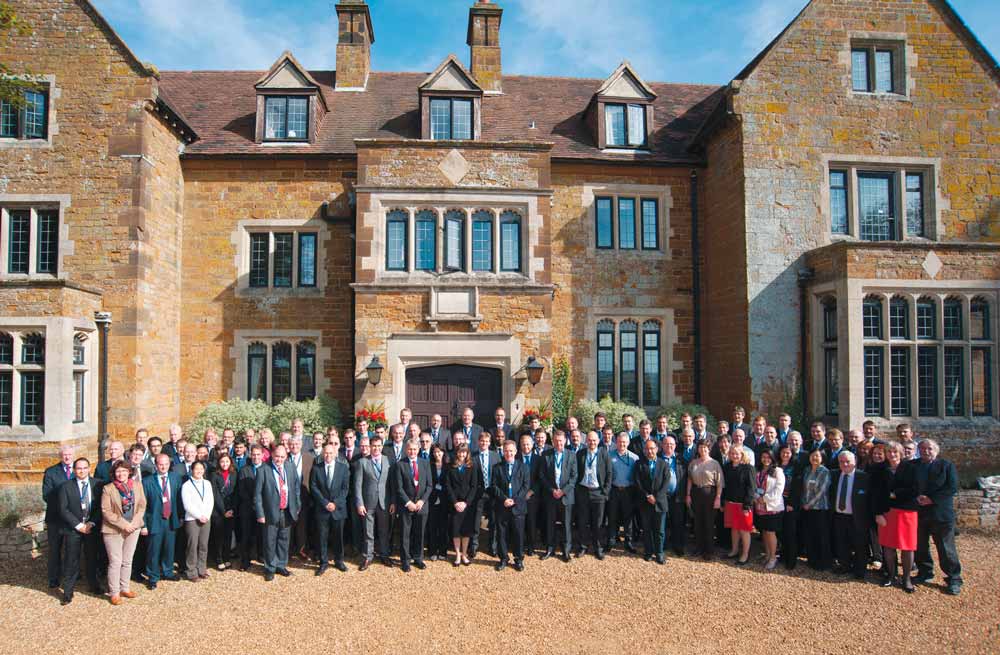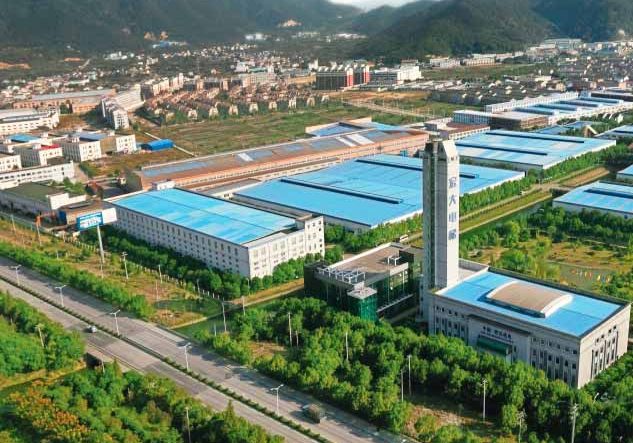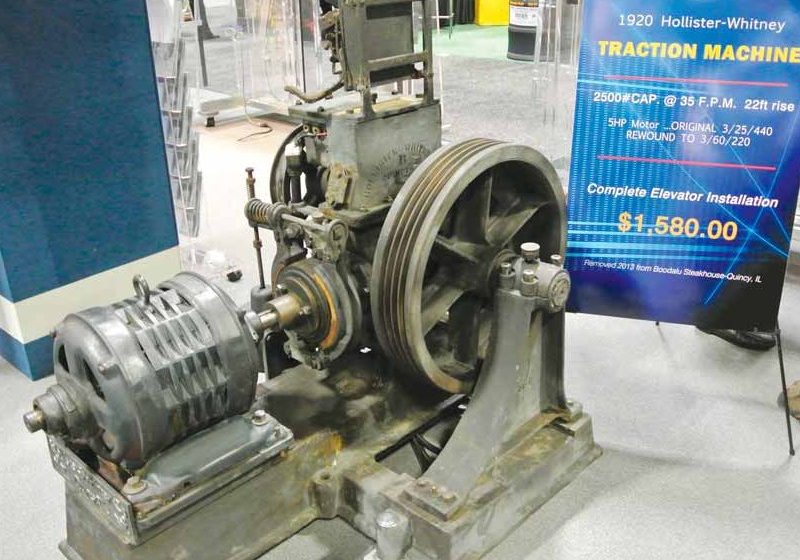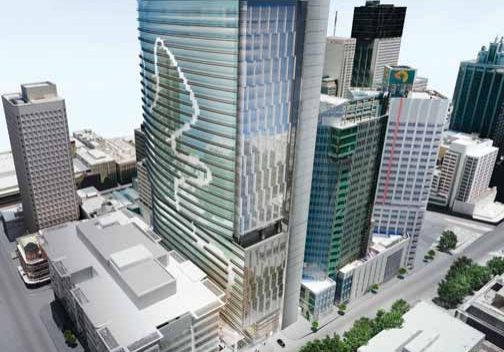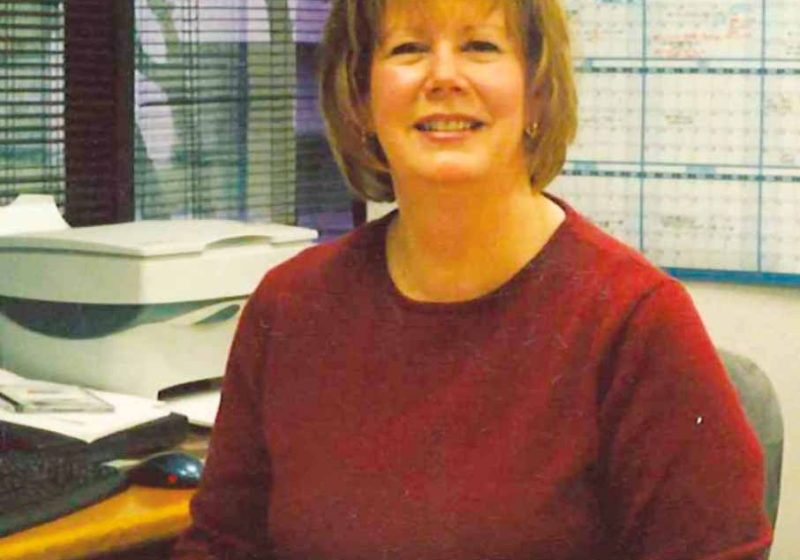The third-annual Symposium on Lift and Escalator Technologies was held in the splendid surroundings of Highgate House Hotel on the outskirts of Northampton, the traditional home of lift engineering in the U.K., on September 26-27. The event was fully booked, with delegates coming from all corners of the globe.
It was inevitable that handling capacity would be a topic of discussion, and, fittingly, delegates were greeted in the courtyard by a classic London double-decker bus — in this case, a former London Transport RML, the high-capacity version of the Routemaster designed for major central London routes. Its extra capacity was obtained by adding a 2-ft., 4-in. bay in the center of the body. The traditional surroundings also included an original, red telephone box. The organizing committee chose the venue for a number of reasons, including its location and facilities, which turned out to be superb. The transition of presentations was seamless. The food was good, too, and every member of the hotel team did everything they could to make the symposium a great success.
After registration and coffee on the first day, Professor Kamal Bechkoum, dean of the School of Science and Technology at the University of Northampton, welcomed the delegates. We then went straight into session one, which dealt with passenger comfort. The session, chaired by your author, was opened by Dr. Rory Smith who gave a fascinating talk about his paper, “Lift Cabin Ventilation, Code Requirements and Experimental Results,” based on practical tests undertaken in the Middle East. The second paper was presented by Professor Stefan Kaczmarczyk, chair of the Postgraduate Field of Lift Engineering, Department of Engineering and Technology at the University of Northampton, and looked at vibration problems in lift and escalator systems, the range of analysis techniques available and mitigation strategies to overcome vibration problems. Both speakers provoked questions from the audience about these two important subjects, which most of us have experienced in day-to-day life in the lift industry.
After coffee, Adam Scott took the chair for a session on traffic design. Marja-Liisa Siikonen presented the first paper, which looked specifically at traffic patterns in hotels and residential buildings — again, a subject designers in the lift industry face often. Siikonen was followed by Rosa Basagoiti, who presented a multi-authored paper about passenger-flow pattern learning based on trip counting in elevator systems combined with real-time information. Another paper that provoked discussion was about the intricacies of data gathering. The final paper before lunch was presented by Stefan Gerstenmeyer and entitled “A Review of Waiting Time, Journey Time and Quality of Service.” This paper gave a very interesting overview of research into queuing and the perception of it.
The event was fully booked, with delegates coming from all corners of the globe.
The first afternoon session on day one was chaired by Dr. Gina Barney and continued the theme of traffic design. The first paper was presented by Dr. Lutfi Al-Sharif and entitled “Converting the User Requirements into an Elevator Traffic Design: the HARint Space.” This was another multi-authored paper, also bringing many questions from the floor. The second paper was presented by Len Halsey. Entitled “Lift Design for Modern Office Buildings; What is the Market Looking For?” it looked at the real-world experience of a major London developer looking to maximize his investment and give tenants a design that met their needs, while keeping accommodation options open for the future. Since developers were looking for a ratio of one to eight with no allowance for absenteeism, it provided food for thought on occupancy rates.
Once again, the discussion continued over coffee before the final session of day one, which was chaired by Smith. The opening paper of this session was entitled “Modeling of Simulation of the Dynamic Behavior of Elevator Systems” and was presented by Seyed Mirhadizadeh. The second paper, “Modeling and Simulation of a High-Rise Elevator System to Predict the Dynamic Interactions Between Its Components,” continued the theme of simulation. It was presented by Rafael Sanchez Crespo on behalf of its authors.
Following a full day, delegates continued their discussions before the gala dinner, held in the Coote Room. The dinner provided a good chance for delegates to socialize and meet new colleagues, as well as catch up with old friends. During the dinner, Professor Nick Petford, vice-chancellor of the University of Northampton, acknowledged the unique contribution the lift industry has made to the success of the conference series. Dr. Barney was acknowledged for her work in the industry over many years, which culminated in her receiving an Honorary Fellowship of the Chartered Institution of Building Services Engineers (CIBSE). Elizabeth Evans was also acknowledged for the incredible amount of work she put into organizing the symposium, as, without her attention to detail, it most certainly would not have been the event it was.
The papers presented at the symposium covered a broad range of topics relevant to the theory and practice in the field of elevator and escalator technology.
The second day opened with your author giving a presentation about the Emirates Airline cable-car system in London and discussing the very different ways the cableways and lift industries are regulated, and governed by and held to standards. Following this, Alberto Pello presented a paper entitled “Application of Linear Motor Technology for Variable Speed Passenger Transportation Systems,” which looked at matters such as high-speed movement of passengers on moving walks over significant distances. The final paper of the opening session was given by Nick Mellor, who discussed the performance of nonlinear energy-accumulation buffers. His paper prompted discussion about the performances of buffers in different environmental conditions.
After the coffee break, the sixth session of the symposium was chaired by Siikonen and focused on traffic design. Dr. Richard Peters, CIBSE Lifts Group and managing director of Peters Research Ltd., presented the opening paper, entitled “The Application of Simulation to Traffic Design and Dispatcher Testing.” This was followed by Al-Sharif with a paper entitled “Derivation of an Elevator Round Trip Time Formula Under Up Peak Traffic for the Case of Four Special Conditions.” The final paper of the session was presented by Theresa Christy. It looked into common misconceptions regarding elevator traffic simulations. It was an interesting paper highlighting the common claims we have all heard — myths that have found their way into the annals of lift-engineering history.
The session closed for lunch, and we gathered again promptly afterward for the final session, which looked at standards. It was chaired by Peters, and the opening paper came from Ian Jones, who chairs the U.K.’s British Standards Institute (BSI) MHE/4 committee. Jones highlighted the many changes that will befall the industry when EN 81-20 and EN 81-50 replace the aging EN 81-1 and EN 81-2 standards. All I can say is, “Consultant, contractor and supplier beware — there are changes ahead, and if you want my advice, be a good scout and be prepared!”
The final paper was jointly presented by Dr. Barney and Ana-Maria Lorente-Lafuente and looked at “Simplified Energy Calculations for Lifts Based on ISO/DSO 25745-2.” Lorente-Lafuente is a PhD student looking at energy consumption in regard to lifts, and there is a lot of good information coming from this research.
Kaczmarczyk commented:
“The papers presented at the symposium covered a broad range of topics relevant to the theory and practice in the field of elevator and escalator technology. The importance of technical issues concerning structural integrity, efficiency, safety and reliability of vertical-transportation systems addressed during the proceedings cannot be overestimated. Acknowledging the international research interests within the event’s area, the symposium has enabled new connections between academic and industry experts across the disciplines relevant to elevator and escalator technologies.”
Peters commented:
“Feedback from this year’s symposium has been unanimous in praising the speakers, organization and venue. We are very grateful to all those who took part, and are looking forward to receiving speaker abstracts for next year via www.liftsymposium.org. For me, personally, the 2012 symposium was a great event. I had the great pleasure of writing that event up for the trade press, as well, but 2013 has moved the symposium into a higher level. The decision to make it two days instead of one and to make the brave decision to move it from its spiritual home at the University of Northampton to the Highgate House Hotel, which gives the comfort of having accommodation to support the event, as, in my opinion, a good decision.”
There were a number of other positives that came from the two-day event, such as seeing delegates travel from all around the globe to be there. We also saw the enthusiasm and dedication of a number of research students, and we got to hear that the University of Northampton is in the running for a prestigious award.
Dr. Jonathan Adams wrapped up the event and encouraged us to think about the future of our industry and promote engineering as a career.
Last year, I made mention of the fact that everyone stayed to the end, and conversation continued after proceedings had closed; this year was no exception. The success of the event is such that we are able to announce that the 2014 symposium will be held on September 25-26. Another piece of advice — book early as we had to turn last-minute applicants away this year. If we know early enough that you are coming, we will have time to adjust and accommodate.
Get more of Elevator World. Sign up for our free e-newsletter.
